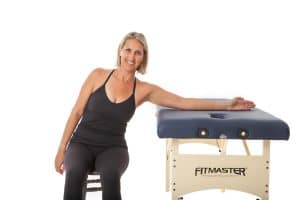
Customized Exercise Programming - Brain Cancer
Susan received a referral for a client with brain cancer. She has been a Cancer Exercise Specialist for three years, and this is her first client with brain cancer. She asked if she could hire me to help her with Barb’s exercise program and teach her how to put the program together. She completed her initial assessment and health history and shared the following information with me:
- Barb is 58 years old and was in the best shape of her life prior to her cancer diagnosis
- She is 5’7 and currently 170 lbs. She has 24% body fat
- Other than slow walks with her dog, Barb has not exercised regularly since her diagnosis. After about 5 minutes of walking she says that her lower back hurts
- She was diagnosed with a grade II meningioma and underwent a craniotomy on 1/15/2022
- She is currently undergoing external beam radiation treatment M-F and takes corticosteroids to reduce swelling. She is tired all the time, very weak, and has a hard time getting out of bed in the morning because she seldom has a good night’s sleep.
- Her BP is 110/85 and her RHR is 78
Postural Assessment:
- Moderate Upper-Crossed Syndrome
- Moderate anterior pelvic tilt
- Struggles with balance particularly on left leg and has neuropathy in both feet and both hands
- Both knees are medially rotated and it becomes even more notable during squat test
- Arms bow out to side on squat test
- Modified Thomas Test confirms tight hip flexors and quads on both sides.
- She has a difficult time with her short-term memory and completing basic tasks
Susan is a bit overwhelmed with the combination of her treatment, side-effects, and physical assessment. She is not sure where to begin.
I started by compiling my own notes and breaking everything down for her one step at a time.
- Because she has neuropathy in her hands, Susan will need to chose upper body exercises that don’t put Barb at risk for dropping the weights or letting go of the bands. She will focus on machines and isometrics for her upper-body workout. Because Barb also has neuropathy in her feet, she will avoid all high impact activities. Susan will chose cardiovascular exercises that will not put her at risk for falling. If her blood counts are good, swimming will be a great option. She has trouble with balance so balance work will be critical, but Susan will start with very basic moves that do not put her at risk for falling.
- Since Barb began radiation she has been vomiting several times per week and has regular headaches. On days that Barb has vomiting, she will need to avoid exercise for 24-36 hours and make sure that she re-hydrates and replenishes electrolytes. If she has spells of nausea, Susan will have her stop exercising, sit down, and drink water. If the feeling does not pass, she will suggest that Barb go home.
- Susan will also incorporate lower-body ‘functional’ exercises, particularly squats to help increase her bone density and perform activities of daily living. She will have Barb put a circular band around her thighs while performing squats to help strengthen the abductors and correct her medial knee rotation. She will also work with Barb on stretches for her adductor complex, quads, and hip flexors. Cardio will help to strengthen her heart and lungs, increase her energy, and help her to lose weight.
- Because of the upper-crossed syndrome, and arms abducting on squat test, Barb needs to stretch both her pecs and lats. She should focus on shoulder retraction and depression to stabilize her shoulder girdle. To strengthen the opposing upper/middle back muscles she will start with rows and reverse flys at a very low weight and just a few repetitions.
- Because Barb is extremely fatigued, Susan is suggesting she exercise for 20-30 min. 3-4 times a week, or as-tolerated. On days that Barb doesn’t feel like she can make it to the gym, Susan gets on ZOOM and guides her through deep-breathing and stretching exercises.
- After Susan completed the Modified Thomas Test on Barb she was able to confirm her findings of tight adductors/weak abductors, but also noted that she had incredibly tight quads on both sides. She will recommend stretches for her quads as well as supine hamstring curls with a physioball. This will help to create more balance and symmetry between these two opposing muscle groups.
- Susan wants to get Barb in a swimming pool ASAP, but will wait until her blood counts improve.
- Corticosteroids can add to her fatigue and memory problems as well as increase depression and weight gain due to fluid retention. They can also increase her risk for osteoporosis, diabetes, and high blood pressure. Weight- bearing exercise will be critical, but Susan knows that she will need to slowly incorporate these exercises taking into consideration Barbs’ energy level, balance, and neuropathy.
- Susan will refer Barb to a Registered Dietician who specializes in oncology to help put together a meal plan that will assist her in safely reducing her calories while maintaining lean muscle mass.
Once I gathered my thoughts, I was able to come up with the following workout routine for Susan to facilitate with Barb for her initial 6-8 weeks.

Balance exercises and core exercises will be critical for fall and injury prevention. Susan must make sure that Barb has something stable to hold on to, or has a spotter until she feels more confident in her own abilities. Susan encourages Barb to stand on one leg, whenever she feels up to it, to increase the length of time that she can hold her balance. When she can do this with no problem, she will have Barb perform the same exercise on an Aerex pad.
2 x PER WEEK Lower-body strength training – starting with functional training. Susan will place a band around Barb’s thighs and instruct her to do squats while gently pushing her thighs outward . They will aim for 5-6, but stop if Barb gets too fatigued. Susan will also have her do side-lying clams. She will place a pillow under her head and make sure her spine is in alignment. They will aim for 8-10 reps on each side. Fatigue will be the determining factor for the number of reps as they progress. Susan needs to make sure that whatever they do gives Barb more energy rather than causing her to be more fatigued.
On two of the non-leg days Barb will perform exercises that challenge her memory. Susan will have Barb perform a set of 6 reps of a particular movement; let’s say toe raises. Then she will add another exercises; maybe side steps. Barb will have to remember the first set of toe raises, perform 6 of them, do another set of side steps, and then Susan will add another exercise and so on and so on. Sometimes Barb gets frustrated when she can’t remember what comes next and Susan reminds her that many of the side-effects of treatment will lessen or go away completely over time. Susan encourages her to keep pushing ahead, but also knows when Barb needs to take a “step back.”
Susan will re-assess Barb in 8 weeks and either continue with this routine, or progress to longer duration of cardio, more repetitions, and the addition of more strength training exercises.
If you are in need of assistance with a special-needs or physically-challenged client, you can get Andrea Leonard’s help in with custom exercise programming.

